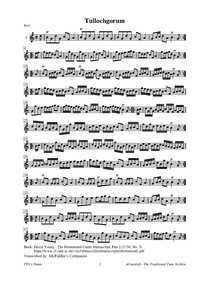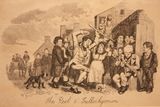Template:Pagina principale/Vetrina: Difference between revisions
No edit summary |
No edit summary |
||
| Line 5: | Line 5: | ||
|f_tune_name=Tulloch Gorum | |f_tune_name=Tulloch Gorum | ||
|f_track_title=Tulloch_Gorum_(1) | |f_track_title=Tulloch_Gorum_(1) | ||
|f_section= | |f_section=X4 | ||
|f_played_by=[https://soundcloud.com/puirtaoque Puirt A Oque] | |f_played_by=[https://soundcloud.com/puirtaoque Puirt A Oque] | ||
|f_notes= The Reel of Tullochgorum, by Walter Gelkie (1795-1837). | |f_notes= The Reel of Tullochgorum, by Walter Gelkie (1795-1837). | ||
Revision as of 10:25, 15 July 2023

Played by: Puirt A Oque
Source: Soundcloud
Image: The Reel of Tullochgorum, by Walter Gelkie (1795-1837).

The earliest record of this tune in more or less modern form is as a rant entitled "Tullochgorum" in Edinburgh writing master and amateur violinist David Young's Drummond Castle Manuscript, Part 2 (1734, No. 3).
It is also found in the James Gillespie Manuscript of Perth (1768). These early versions show little of the later strathspey rhythm, at least as noted, and appear as rants. However, in Robert Bremner's 1757 collection (2nd part, p. 16) it is set as a strathspey.
Tullochgorm is also the name of a Scottish dance of twelve steps, and was one of several taught by Cape Breton fiddler Donald "the Tailor" Beaton of South West Margaree (who was an itinerant tailor).
Lore surrounding the dance says that the movements are supposed to relate to the small hills or knolls that lookouts stood upon, looking for the foes of Bonnie Prince Charlie. Supposedly they performed the dance while on duty, so as not to look suspicious.
One dance teacher (Fearchar MacMeil of Barra) said the Green Knoll was where Bonnie Prince Charlie and Flora MacDonald said farewell. There is no evidence to suppose that any of this is actually true; rather it smacks of Highland romanticism.
...more at: Tulloch Gorum - full Score(s) and Annotations
X:4 T:Tullochgorm’s Reel [1] M:C L:1/8 R:Strathspey B:Cumming - A Collection of Strathspey or Old Highland Reels (1782, No. 8, p. 3) Z:AK/Fiddler's Companion K:G V:1 clef=treble name="4." [V:1] A|B<Gd>G c>F A2|B<Gd>G TB>cd<g|B<Gd>G c>FA<c|BG B/c/d c2B:| |:A|G>g d>e =f>F A2|G>gd>e =f>ga>g|=f>ed<f c>F A2|1 G>g d>e c2B:|2 g>d g<a e/<^f/g d/<g/g|| |:A|B>G d>G c>=F A<c|B>Gd>G e>Gd>G|B>Gd>G c>FA<c|B<G B/<c/d c2B:| |:A|G>gd>g =f<FA>B|G>gd>g B>gd>g|G>gd>g =f>FA<B|G>gd<g c2 TB>A| G>gd<g =f>FA<B|G<gd>e =f>ga>f|g>ef>d c<FA>^f|gd g/a/b g2 dg:||
